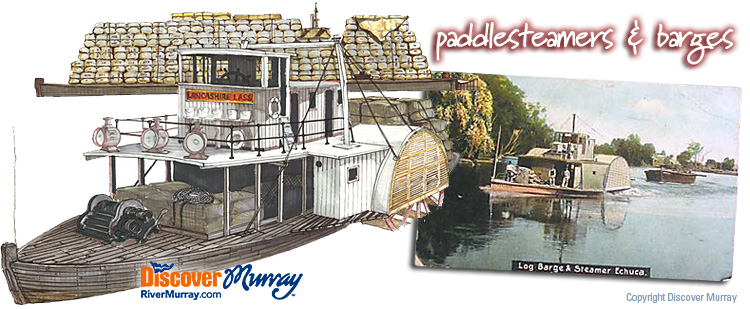
Barges were vital for moving goods on the Murray River
A typical barge had big empty hulls with two or three holds separated by bulkheads. A tiny forecastle was located under the front deck and a low hatch-coaming ran all round the top of the hold to prevent water from entering.
The early barges were built mainly of red gum and were quite narrow, later barges were wider and of composite wood and steel construction. Red gum was the favoured timber as it was plentiful and strong. It tended to swell when soaked in water and closed up tight on the barge.
Loading the barge was a precision exercise of weight distribution and balance. The first layer of wool bales went into the hold leaving a space at the sides for deckhand access and for water pumps. The next layer above deck was stacked to the outside edge of the coaming. Around that layer of bales ran a ‘ring’ rope, a wire cable that circled the whole layer. Cross lashings, about 3 m apart, ran from one side of the barge, between the bales and were tied off to the ‘ring rope’ on the other side.
Each successive layer was stepped 300mm inboard from the previous layer and tied off. Sometimes up to 5 layers were stacked above the deck. The last layer, called the ‘rider’, topped off the pyramid of bales. It consisted of a single row of bales running down the centre of the load and became the balance layer for the barge. When the load had been stacked correctly the ‘rider’ would sit directly above the centre or keel line. If, because of careless stacking or uneven weight of the bales, the rider would be placed to the left or right of the centre line and correct the inbalance.
The whole load was then cross lashed with the ‘up & down’ lashings. These wire ropes, tied off to ring bolts on the deck, passed over the ‘ring ropes’, across the top of the load, to the ring bolt on the opposite deck. Tying off the load was absolutely necessary, so if the barge hit an obstruction the load would not move.
While each layer was being stacked, the steering gear was lifted so it remained on top of the load and in its final position gave the bargemaster unrestricted vision of the barge and its load. Just behind the steering wheel a hole was left in the layer of bales, into which the bargemaster could drop, if the barge was pulled under low, overhanging trees.
Tow ropes from the paddle steamer were attached to the tow pole, a sturdy structure usually in the centre of the craft above the cabins. On the barge it was attached to the stem-post. The average length of tow ropes was about 30 m.
Stopping a barge was not easy. One method was to let the momentum of the craft gradually slow to a stop. The other was to let the barge glide past the towing steamer then a rope was thrown to the barge deckhand who tied it off to the bollard or stern post. If the deckhand missed catching the rope, or missed the bollard, the barge continued on, or if he was too slow or clumsy with tying off the rope he probably would be minus a few fingers.
History of Murray-Darling Paddle steamers | Barge Photos
The first paddle steamer race between Randell & Cadell
Tell your friends you found this at murrayriver.com.au!
Copyright Discover Murray 2025. This site or any portion of this site must not be reproduced, duplicated, copied, sold, resold, or otherwise exploited for any commercial purpose that is not expressly permitted by DISCOVER MURRAY.






 Amy Shark The Solo Acoustic "Songs & Stories" Tour
Amy Shark The Solo Acoustic "Songs & Stories" Tour Lee Kernaghan Boys From The Bush The Concert
Lee Kernaghan Boys From The Bush The Concert The Australian Beach Boys Show
The Australian Beach Boys Show Kevin Bloody Wilson Aussie Icon Tour with special guest Jenny Talia
Kevin Bloody Wilson Aussie Icon Tour with special guest Jenny Talia Little By Little
Little By Little
